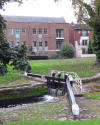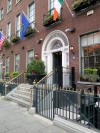












Ireland '23 - Day 4 & 5 - Dublin to Killarney
return to Ireland 23 index
return to mdimage index
On Monday, after another early breakfast, there was plenty of time to get organized & packed, and I took an hour's walk SE through Merrion Square, then beyond the spot I'd reached before on the Grand Canal, almost to the Grand Quay, and back, via new routes both ways, with online guidance, only if needed.
The Hotel called a cab to Heuston Station, for an 11 am departure to Killarney. I had time for another Nero coffee and talked with a couple going to Cork on the same train, who were in Dublin visiting two generations of offspring.
note - you can enlarge any part of a picture by left-clicking in and then out again (but not with smatphones).
It was a two-hour train ride to Kilarney, heading SW on larnod Eireann (Irish Rail). We were cruising at 80 mph through open farmland & small town stops came up every so often. At every one, a few automated messages were heard, like "mind the gap" and the last one is always "thank you for riding larnod Eireann, which in spoken Gaelic sounds exactly like "nor here nor there".
It was amusing....."mind the gap, and, thank you for riding 'nor here nor there'.
There was a 10 minute train switch at Mallow, and the next train headed straight west for 50 minutes. As you approach Killarney, the scenery keeps improving.
The town is in a gorgeous setting, with large lakes & impressive mountains, all around. Tourists have been coming here for 200+ years. Walter Scott and later Queen Victoria brought this area to the attention of wealthy Europeans, promoted as being like England's Lake District.
Killarney National Park starts in town, and has miles of walking trails near the lakes, all paved, for the benefit of the "jaunting cars", or horse-drawn lorries. There is a separate system of dirt or gravel crossing paths for walkers & bikers.
 |
Randle's w/restaurant to the left |
 |
the only pelicans in Killarney |
 |
view of mtns. from my room | |
 |
Monday afternoon on one of the main streets |
 |
It was a quiet afternoon in Killarney. I purchased hiking socks at an outdoor equipment store and had a coffee at a French Cafe. Killarney of course has a lot of restaurants & a handful of traditional pubs, and you can hear Irish traditional music here, every night of the year.
I enjoyed dinner at Randle's, the hotel being situated on a bluff, with a view looking over the rooftops to the surrounding mountains. A small natural gas fireplace added ambience & the food here was impressive.
On Tuesday, I was up early again, enjoying Barry's tea while reading the Judge's book, prior to an 8 am breakfast. An inch of rain plus wind was predicted for the day.
Torq Waterfall - I was the only one on the 9 am HOHO bus to the waterfall car park & took the moderate (blue) trail. It was a little rainy, but not cold or windy.
I saw 2 joggers and 2 other hikers out, and the falls loop was 4 miles with at least 500 ft. of gain, an easy walk.
note - the old Kenmare road may be in poor condition, but it is a great (& isolated) mtn. bike ride, and the 36 mile ride from Kenmare to Killarney gains 1,800 ft.
Muckross House - Descending steadily from the Torq car park, I somehow walked past the Muckross estate for about a half mile before realizing I'd missed a turn. When I headed back, the wind was intense with sideways rain, so I was wet & cold when I finally arrived at the Muckross House entrance.
Inside it was overly warm, and I enjoyed a relaxed stroll through the place. I didn't know the first thing about it. There are 65 rooms, but tourists only see 15 of them. The most important rooms had informative docents, usually with a captivated audience, and I tended to breeze past.....
History - A wealthy American family from Philadelphia - Henry Arthur Herbert and his wife, watercolorist Mary Balfour Herbert - built the house in a Tudor style and moved into the place in 1843 (there's more below, see Postscript).
 |
back yard at Muckross House |
 |
must-have European art |
 |
Muckross Lake from second floor bedroom | |
 |
Emily Keane |
 |
 |
not an Irish harp | ||
 |
old dishes |
 |
 |
tea cups and saucers | ||
 |
 |
fortress Randle |
Muckross House, cont'd - From a second floor window, I noticed that the parking lots outside were full, so a lot of people were visiting today. One of the main attractions is the Garden Cafe, with a large & impressive hot food layout, highly regarded & mentioned in guide books.
I had a scone & Americano, content to dry out & observe. The majority of the diners appeared to be Irish, mostly my age & older, nicely dressed, probably having a "grand day out"......enjoying a fall lunch feast, after touring a fancy old House. Or maybe they were celebrating the end of the tourist season?
If it is not raining the grounds here are vast & worth exploring, for instance there's a nearby Abbey ruin with a maintained walled garden, plus forests w/giant trees, and of course the lakes.
Being the last passenger on the bus back to town, the driver kindly let me off across the street from Randle's. It was time for dry socks, Barry's tea, and more reading.
Later in the day the rain stopped, so I walked into town again, with no purpose. I read posted menus at a few places but settled for dinner at Randle's, once again. At 5 pm it was completely uncrowded and service & food were great.
Go to next page - Knights Town & Portmagee
return to Ireland 23 index
return to mdimage index
Postscript - The Herbert family eventually sold Muckross House to the Guinness family, who used it for some time as a hunting lodge & later sold it to the Bourn family, wealthy Californians. In 1932, after residing in the home for two generations, the family presented the house and 11,000 acres to the Irish Nation, and it soon became the first National Park in the Republic of Ireland, and formed the basis of the more modern (and much larger) Killarney National Park. (ref. - Wikipedia)
Go to next page - Knights Town & Portmagee